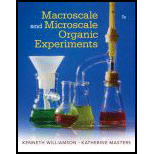
Macroscale and Microscale Organic Experiments
7th Edition
ISBN: 9781305577190
Author: Kenneth L. Williamson, Katherine M. Masters
Publisher: Brooks Cole
expand_more
expand_more
format_list_bulleted
Question
Chapter 9, Problem 4Q
Interpretation Introduction
Interpretation:
The importance to allow the liquid level in the column to drop to the level of alumina before the solution of the compound is separated should be explained.
Concept introduction:
A separation technique used for the segregation of components of chemical mixture based on the difference between the adsorption of different components in stationary and mobile phase is called column chromatography.
It is used for purification or segregation of compounds. It consists of two phases namely:
- Stationary phase (solid)
- Mobile phase (generally liquid)
Silica gel is commonly used as the stationary phase.
Expert Solution & Answer
Trending nowThis is a popular solution!

Students have asked these similar questions
Write the advantages and disadvantages of Liquid chromatography compared with Gas chromatography.
what is chromatography? Explain different types of chromatography and explain how to seperate compounds. indicate stationary phase mobile phase.
[1] In paper chromatography, why do some ions move only a short distance from the point of application
while others move much more?
Chapter 9 Solutions
Macroscale and Microscale Organic Experiments
Knowledge Booster
Recommended textbooks for you
 Macroscale and Microscale Organic ExperimentsChemistryISBN:9781305577190Author:Kenneth L. Williamson, Katherine M. MastersPublisher:Brooks Cole
Macroscale and Microscale Organic ExperimentsChemistryISBN:9781305577190Author:Kenneth L. Williamson, Katherine M. MastersPublisher:Brooks Cole Principles of Instrumental AnalysisChemistryISBN:9781305577213Author:Douglas A. Skoog, F. James Holler, Stanley R. CrouchPublisher:Cengage Learning
Principles of Instrumental AnalysisChemistryISBN:9781305577213Author:Douglas A. Skoog, F. James Holler, Stanley R. CrouchPublisher:Cengage Learning

Macroscale and Microscale Organic Experiments
Chemistry
ISBN:9781305577190
Author:Kenneth L. Williamson, Katherine M. Masters
Publisher:Brooks Cole


Principles of Instrumental Analysis
Chemistry
ISBN:9781305577213
Author:Douglas A. Skoog, F. James Holler, Stanley R. Crouch
Publisher:Cengage Learning